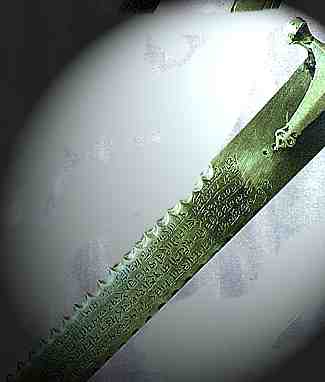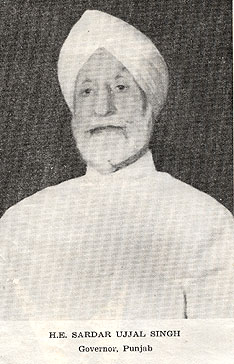


MEMORABLE WELCOME TO RELICS

' Delhi citizens turned out in lakhs to give a memorable welcome to the holy relics of Guru
Gobind Singh, the tenth Sikh Guru. The sacred arms arrived from London in January, 1966, where they had been kept for 116 years.
The weapons, which struck terror in the hearts fill of the enemy about 300 years ago and were described by a historian as "warlike symbols of a warlike faith", were flown from London via Bombay.
As the JAC Caravelle, "Akashdoot" touched down at Palam airport at exactly 13-30 p.m., a wave of cheering humanity rushed towards it.
The Prime Minister received the weapons from an official of the airline and handed them to Sardar Ujjal Singh, Governor of Punjab who in turn passed them to "panj piaras".

The devouts bowed their heads and stood with folded hands muttering prayers. Ninety-one Akali volunteers in white shirts and churidars with yellow cummerbands round their waists and shining named swords in their hands raised the slogan "Sat Sri Akal". Simultaneously a trainer aircraft zoomed overhead and showered rose petals.
The Sikh Regiment Centre Band from Meerut rendered a hymn of Guru Gobind Singh. "Deh shive Bar Moh Eh Hae". It was a prayer to God to give him the strength never to hesitate from doing good work.
The 34-member band in resplendent red turbans and tunics provided a magnificent splash of colour in a gathering predominantly of men in winter clothes of dull, grey shades.
The band played a ''Shabad" of Guru Nanak, a classical tune and finally a hymn in praise of the country ("Deshon ka sartaj") as the weapons were carried to a white-draped platform set up under a shamiana.
The Prime Minister, the Acting Governor of Punjab, the Union Home Minister, Shri G. L. Nanda, the Chief Minister of Punjab, Shri Ram Kishan, and other dignitaries accompanied the short procession from the gangway to the platform.
Shri Y. B. Chavan, Union Defence Minister, Air Marshal Arjan Singh, Chief of the Air Staff, Sardar Swaran Singh, Minister for External Affairs, Sardar Hukam Singh, Speaker of the Lok Sabha, Mr. Nurudin Ahmed, Mayor of Delhi, Punjab and Kashmir Ministers and Delhi Jana Singh leaders were also present.
WELL PRESERVED
The weapons, appeared to have been well preserved and were wrapped in yellow silk cloth. They included a 'dhal' (shield), 'dae-e-ahinee' (an iron weapon), 'shumsher, teghah' (scimitar), a 'chakra' (golden quoit), 'burcha' (small spear) and a 'burcha' (long spear).
They were placed on a decorated trolley to be taken in procession from the airport to Gurdwara Rakabganj. Prominently on the trolley was a portrait of Guru Gobind Singh.
The colourful procession led by the Nigara (Sikh traditional drum), was composed of five elephants, 12 camels, 101 horses (the riders in traditional dresses and bearing arms), 500 men in uniform and arms, 2,000 members of the Shastra Vidya Dal (displaying their skill of arms) and jathas of Namdharis, Nihangs, school children with their bands R.S.S. and N.C.C. cadets.
The procession wended its way through Maude Road, Parade Road, Gurgaon Road, Dhaula Kuan,
Sardar Patel Road, Willingdon Crescent, Irwin Road, Connaught Place, Parliament Street, Tal-katora Road and Pandit Pant Marg.
Cheering crowds that lined the route of the procession joined it after paying their obeiscence to the weapons. Like a mighty river, the procession swelled as it progressed. In Connaught Place it assumed the shape of the sea of humanity.
At Gole Post Office the procession was reorganised. A number of school bands and children in school uniform joined the procession.
In the middle of the procession were young Sikhs dressed as warriors. Some of them gave a demonstration of their skill in sword fighting and lustily cheered by the crowd.
It was one of the most spectacular procession seen in Delhi for a long time and it took about six hours to cover the 12 mile distance from Palam to Gurdwara Rakabganj.
As the trolley carrying the sacred weapons entered the Gurdwara the devouts bowed their heads or offered flowers.
An elaborate programme was drawn up by the Delhi Gurdwara Prabandhak Committee to give the relics a welcome such as the Capital had never witnessed.